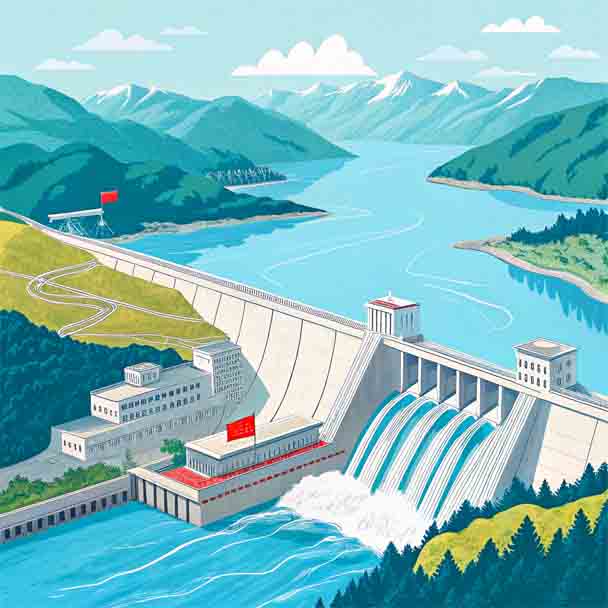China Is Turning 12 Trillion Liters of Water into Energy – The Silent Giant of Hydropower
China is turning 12 trillion liters of water into energy through the Xiluodu Hydropower Station—an engineering marvel surpassing expectations in clean energy.
When people think of Chinese hydropower, the Three Gorges Dam often comes to mind. But hidden upstream along the Jinsha River lies a structure equally monumental—Xiluodu Hydropower Station, a project so vast that now China is turning 12 trillion liters of water into energy every year.
This isn’t just about electricity—it’s about shaping the future of renewable energy in one of the world’s fastest-growing economies.
What Is the Xiluodu Hydropower Station?
Strategically nestled between the Sichuan and Yunnan provinces, the Xiluodu Hydropower Station stands tall at 285.5 meters, with a massive double-curved concrete dam that reshapes the geography of the Jinsha River.
With a power generation capacity of 57.12 billion kilowatt-hours (kWh) annually, this plant is China’s second-largest hydropower station—only behind the Three Gorges—and the third largest in the world.
But more than size, it represents a transition towards sustainable energy, balancing power production with flood control, sediment retention, and navigation.
12 Trillion Liters into Energy: The Numbers
The magic lies in 12.67 billion cubic meters of reservoir capacity—roughly 12 trillion liters of water. This water fuels 18 turbines, each with a jaw-dropping capacity of 770,000 kW, making the total installed capacity 13,860 MW.
Impressive Features Include:
-
200 km long reservoir
-
Up to 700 meters wide basin
-
$10 billion total construction cost
-
Started construction in 2007
-
Operational since 2013
All these numbers reveal how China is quietly rewriting global energy dynamics with this one project.
Smarter, Greener Energy for Millions
China’s “West-to-East” power transmission strategy gains momentum with Xiluodu. Power generated here travels through two high-voltage direct current (HVDC) transmission lines:
-
1,680 km to Zhejiang Province
-
1,286 km to Guangdong Province

These transmission lines carry up to 14.4 GW of clean electricity to China’s industrial zones, reducing coal dependency and boosting national energy security.
The Engineering Masterpiece: Beyond Just a Dam
What sets Xiluodu apart is its multi-functional design and advanced tech. Its five floodgates can discharge water at up to 50 meters per second, including the world’s heaviest gate weighing 1,600 tons.
Key Functions:
-
Flood Control: Capacity of 4.65 billion m³
-
Navigation Improvement: Smooths out river travel
-
Sediment Retention: Keeps waterways clean
-
Climate Resilience: Upgraded flood resistance for major cities like Yibin, Chongqing, and Luzhou
It isn’t just a powerhouse—it’s a national defense asset, water management tool, and climate change mitigation infrastructure rolled into one.
Social and Environmental Costs
Despite its benefits, the project came at a human cost. About 180,000 people—mainly rural communities—were relocated for the reservoir.
Ecologically, the rapid filling of the reservoir in 2013—rising 100 meters in just 51 days—caused severe ecological disruptions and affected downstream flow levels, especially in Luzhou.
Environmental Concerns:
-
Displacement of wildlife
-
Altered aquatic ecosystems
-
Reduced downstream water availability
While the power output is impressive, experts argue that future hydropower must consider more ecological balance and community involvement.
Comparing Xiluodu to Global Renewable Projects
Xiluodu stands shoulder-to-shoulder with global energy behemoths like:
-
Itaipu Dam (Brazil/Paraguay)
-
Baihetan Dam (China)
-
Three Gorges Dam (China)
But where it excels is efficiency and adaptability. It’s part of a larger shift in Chinese energy strategy that now includes solar, wind, and microhydropower innovations—like those in the U.S., where home-based water turbines are being developed.
Related Energy Innovations Around the Globe
While Xiluodu captures hydropower headlines, recent developments have amazed experts across the globe:
-
Multicolored Solar Panels: New panels come in blue, green, turquoise—shocking engineers with their efficiency and aesthetics.
-
Diamond Solar Cells: First-ever solar cell using diamond material unveiled—boasting extreme light conversion rates.
-
Mega Lithium Mines in the U.S.: Extracting 20% of global lithium—around 45,000 metric tons per year—fueling EV and battery sectors.
These breakthroughs, combined with China turning 12 trillion liters of water into energy, signal a transformative phase in clean, diverse global energy generation.
Conclusion: A Dam That Powers the Future
The Xiluodu Hydropower Station isn’t just a dam—it’s a symbol of how China is turning 12 trillion liters of water into energy in a smart, strategic, and sustainable way.
While not as famous as the Three Gorges Dam, Xiluodu’s role in flood control, national power stability, and climate adaptation is enormous. It shows that the future of renewable energy isn’t just solar or wind—water still holds the crown when harnessed with innovation.







